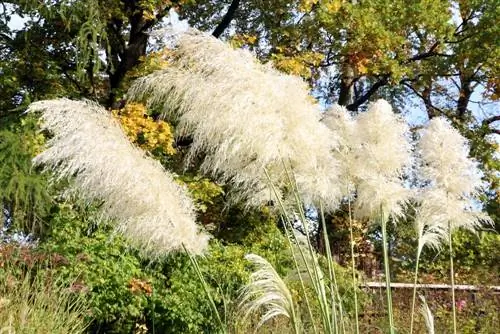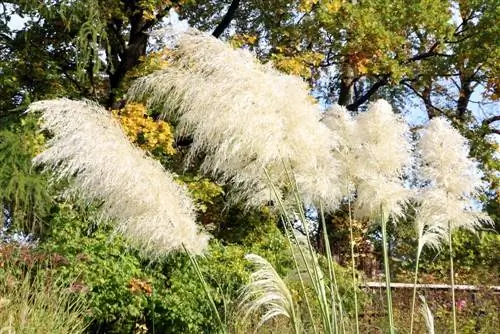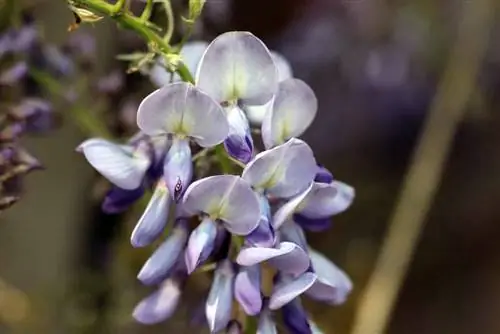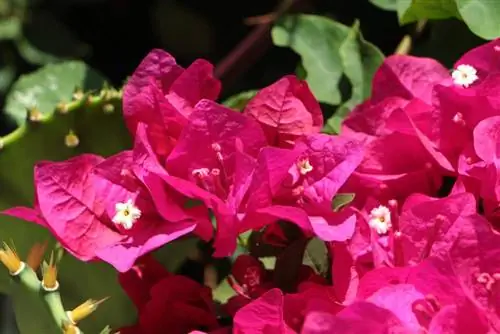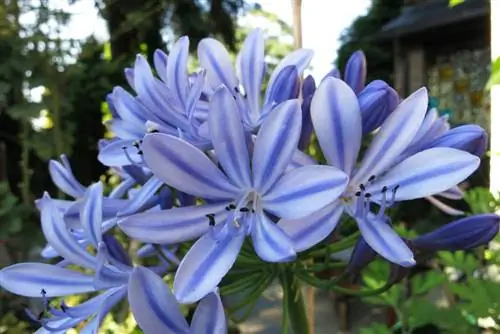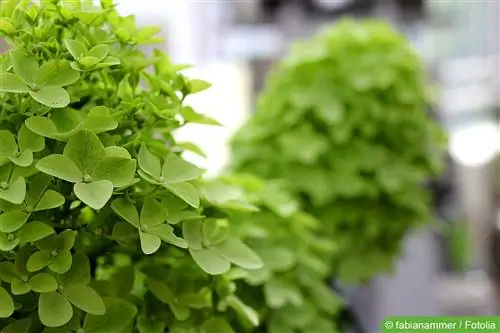- Author admin [email protected].
- Public 2023-12-17 03:39.
- Last modified 2025-01-24 12:45.
Pampas grass is valued not only because of its fast and compact growth, but above all because of the decorative flower fronds that the ornamental grass forms in summer and autumn. That's why there's great disappointment when the long-awaited blossom doesn't materialize. In this article we have put together for you why the pampas grass is not forming new fronds and what you can do about it.
Gender of the plant
Pampas grass (Cortaderia selloana), which comes from South America, is available commercially as young plants in various varieties. Some varieties such as Pumila only grow to around one meter tall, while Silver Comet and Sunningdale Silver can reach heights of up to two meters or even more. Pampas grass is a dioecious grass. This means there are male and female plants. The heavily branched flower spikes on female specimens are particularly lush, while male plants hardly produce any fronds. The fact that male and female pampas grasses are available in stores is due to the different methods of propagation. Plants grown from seeds are usually significantly cheaper than those obtained through vegetative propagation, i.e. division from other female plants. However, when grown from seeds, the gender of the new plant is uncertain.
Tip:
Never sow pampas grass from seeds you have harvested yourself. This does not guarantee that only female plants will be produced. Instead, buy seeds from specialist retailers or divide a richly flowering plant.
Age
Although the perennial is an enrichment for the garden with its approximately one meter long, clumpy and slightly overhanging leaves, the ornamental grass only shines in its full glory when the flower spikes, which are up to two meters high, form all the beauty. Anyone who has bought pampas grass commercially and planted it in their garden is usually waiting impatiently for the first blossoms. However, in this case, a little patience is required because the pampas grass only blooms after a few years. If the flower does not bloom later or if the plant has already bloomed once but no longer does so, care errors or an incorrect location are usually responsible.
Inconvenient location
In nature, American pampas grass grows as a steppe plant on sunny sandy and alluvial soils. In order to develop its full beauty, the plant needs a lot of light and warmth. In a location that is too shady, the ornamental grass will remain without fronds. The same applies to heavily compacted soils or waterlogging. Pampas grass is particularly sensitive to wet soil, especially in winter. Therefore, the garden soil should be deep and well-drained. If in doubt, carefully remove the grass from the ground and dig a larger planting hole at least 60 cm deep and 1 m wide.
- Loose up the ground with a digging fork
- Fill drainage layer
- Enrich the excavation with mature compost or nutrient-rich humus
- Insert the plant as before and fill with soil
- come easy
Water balance
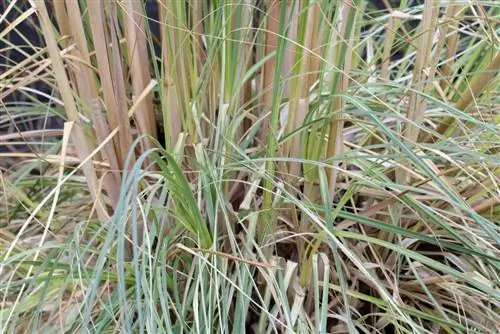
Unlike many other grasses, pampas grass reacts very sensitively to amounts of water that are too high or too low. The sweet grass likes it best when the soil is evenly slightly moist.
drought
Although the plant can tolerate one or two dry days, the root ball should never dry out completely. Water regularly during rain-free periods and hot days, but always make sure that there is no waterlogging. If the location is too dry, it is possible that flowering will be suppressed. If the other site conditions are correct, it can help to dig up the ornamental grass and incorporate mature compost or high-quality humus into the soil over a large area and also into the depths. Both components are able to store water. They do not compact the soil, so there is no risk of waterlogging. In addition, a layer of mulch protects against excessive evaporation of moisture from the soil.
Waterlogging
Because of its reed-like appearance, some gardeners plant pampas grass directly in the bank area of the garden pond. However, it is actually far too wet for the ornamental grass here, especially if the roots are constantly in water. If the plant survives these unfavorable conditions, it is so weakened that it cannot produce flowers. It is urgently necessary to move to a location with permeable soil where the plant has plenty of light.
Incorrect fertilization
Although pampas grass needs a lot of nutrients, it shouldn't be too much. Only with the right dosage will the pampas grass bloom profusely every year.
Inadequate nutrient supply
The American pampas grass prefers nutrient-rich soil. This makes it one of the few types of ornamental grass that require additional fertilizer if the soil is quite poor. It is best to incorporate some compost or nutrient-rich humus into the soil when planting. If there is a lack of nutrients, few or none of the attractive fronds will form. Organic materials such as compost or horn shavings, which are incorporated into the soil at the beginning of the growing season, are suitable for fertilization. You can continue fertilizing every four to six weeks until flowering.
- 50 to 80 g horn shavings or other organic fertilizers per square meter
- do not use mineral fertilizers
Too much fertilizer
The lushly growing sweet grass cannot tolerate very high s alt levels. Therefore, only organic fertilizers that decompose slowly and release their nutrients should always be used. High amounts of nitrogen in the soil do not lead to numerous flower formation, but rather to increased production of leaf mass. Therefore, it is preferable to use low-nitrogen fertilizers. The following are suitable for this purpose:
- ripe compost
- Horn shavings or horn meal
- Ashes from the grill
- special organic fertilizers for ornamental grasses (NPK: 8-2-6)
In order to protect the sensitive roots, fertilizer must be applied in small portions.
Tip:
Stop fertilizing from August onwards so that the grass can prepare for winter rest.
Fertilization of potted plants
Plants grown in pots are an exception to fertilizing. In order to compensate for the nutrients washed out by the irrigation water, these pampas grasses must be fertilized via the irrigation water approximately every two to four weeks with a special fertilizer for ornamental grasses. Please strictly adhere to the manufacturer's instructions. If you repotted the plant in spring, you don't need to add any additional fertilizer at all in the first few months. Good pot substrate contains sufficient amounts of nutrients. If pampas grass does not bloom in the pot even after many years, it may be because the planter is too small. The rootstock requires a lot of space. Therefore the bucket should have a capacity of at least 40 liters.
Tip:
Do not fertilize with nettle manure or any other plant manure. These fertilizers contain excessive amounts of nitrogen.
Incorrect overwintering
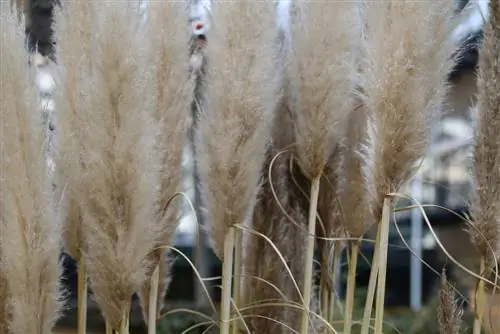
In our latitudes, the pretty sweet grass is unfortunately not completely hardy, even if it is often declared that way. Even more than the cold, wet weather conditions cause problems for pampas grass in the winter months.
If too much water flows into the bale, rot can occur. Although the plant survives in most cases, it is too weak to produce flower fronds. Therefore, before the first severe frosts set in, the ground area should be covered with leaves. It is also necessary to tie the top third of the leaf together with a string to prevent large amounts of water from penetrating the heart of the plant. It is very unfavorable to wrap the ornamental grass in foil, as in this case the air cannot circulate and mold and rot occur.
Cutting time
Only in spring, shortly before new growth in March or April, is the right time to cut back the pampas grass. The right time is very important because if you cut too early, there is a risk that the bale will rot or freeze. If you cut too late, there is a high risk of injuring or even cutting off the new shoots. In this case, the sweetgrass will likely remain without fronds during this growing season. The grass sprouts relatively late. After a cold and long winter, it is completely normal for new stalks to not form until May. Cut back the old, dried-out stalks and flower spikes about 20 cm above ground level.
Pest Infestation
In some cases, the otherwise robust ornamental grass can become infested with aphids. The pests prefer to settle on the underside of the leaves and suck out the plant juices. This can weaken the ornamental grass so much that it will not grow new fronds. In addition, aphids secrete honeydew, a sticky, sugary substance on which sooty fungi like to settle. In the event of a pest infestation, the pampas grass is permanently damaged, which ultimately affects its growth and flower formation. In the best case scenario, you check the grass regularly. If the pests are detected at an early stage, environmentally friendly home remedies usually help. If the plant is already severely affected, pesticides and radical pruning are usually necessary if the grass can still be saved.
Conclusion
As a rule, care errors or an incorrect location are responsible for the pampas grass not blooming. These are quite easy to fix, so that the ornamental grass usually grows new fronds again next year. If the measures are unsuccessful, it is probably a male plant that rarely produces flower spikes.

